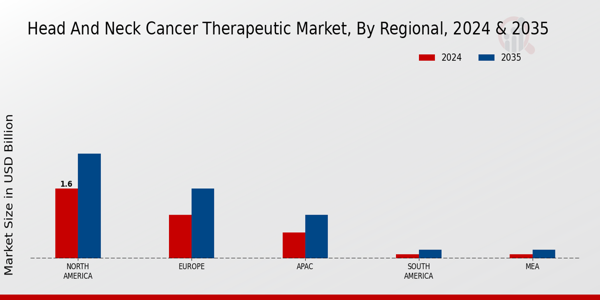Advancements in Targeted Therapies
The Head and Neck Cancer Therapeutic Market is witnessing a notable shift towards targeted therapies, which are designed to specifically attack cancer cells while sparing healthy tissue. This approach not only enhances treatment efficacy but also minimizes side effects, thereby improving patient quality of life. Recent data indicates that targeted therapies have shown promising results in clinical trials, leading to increased adoption among healthcare providers. The market for these therapies is projected to grow significantly, driven by ongoing research and development efforts aimed at identifying new molecular targets. As a result, the Head and Neck Cancer Therapeutic Market is likely to experience a surge in demand for innovative treatment options that leverage these advancements.
Increased Investment in Cancer Research
Investment in cancer research has seen a marked increase, which is positively impacting the Head and Neck Cancer Therapeutic Market. Governments and private organizations are channeling substantial funds into research initiatives aimed at discovering novel therapies and improving existing treatment protocols. This influx of capital is fostering innovation and accelerating the development of new drugs and treatment strategies. For instance, funding for clinical trials has expanded, allowing for more comprehensive studies that can lead to breakthroughs in therapy. As a result, the Head and Neck Cancer Therapeutic Market is likely to benefit from a pipeline of new therapeutic agents that could transform patient outcomes.
Growing Incidence of Head and Neck Cancer
The rising incidence of head and neck cancer is a critical driver for the Head and Neck Cancer Therapeutic Market. According to recent statistics, the prevalence of this type of cancer has been steadily increasing, with a significant number of new cases reported annually. Factors such as tobacco use, alcohol consumption, and the human papillomavirus (HPV) infection are contributing to this upward trend. Consequently, healthcare systems are compelled to allocate more resources towards the development and distribution of effective therapeutic options. This growing patient population is likely to stimulate demand for various treatment modalities, including surgery, radiation, and chemotherapy, thereby propelling the Head and Neck Cancer Therapeutic Market forward.
Rising Awareness and Education Initiatives
There is a growing emphasis on awareness and education regarding head and neck cancer, which serves as a significant driver for the Head and Neck Cancer Therapeutic Market. Public health campaigns and educational programs are increasingly focusing on the risk factors, symptoms, and treatment options available for this type of cancer. This heightened awareness is leading to earlier diagnosis and treatment, which is crucial for improving survival rates. As more individuals become informed about the disease, the demand for therapeutic interventions is expected to rise. Consequently, the Head and Neck Cancer Therapeutic Market is likely to see an uptick in the utilization of available therapies as patients seek timely medical attention.
Technological Innovations in Treatment Delivery
Technological advancements in treatment delivery systems are transforming the Head and Neck Cancer Therapeutic Market. Innovations such as precision radiation therapy and minimally invasive surgical techniques are enhancing the effectiveness of treatments while reducing recovery times. These technologies allow for more accurate targeting of tumors, which is essential in head and neck cancer due to the complex anatomy of the region. Furthermore, the integration of artificial intelligence and machine learning in treatment planning is streamlining processes and improving outcomes. As these technologies continue to evolve, they are likely to drive growth in the Head and Neck Cancer Therapeutic Market by offering patients more effective and less invasive treatment options.


















Leave a Comment